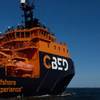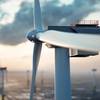A Wärtsilä Lips LJ210E reversible waterjet.
What was once a way to makes waves with small craft, contemporary high-powered waterjet propulsion systems are winding up on bigger vessels including warships.
Why waterjets?
They are simple and reliable, with the pump impellor turning at a constant speed and flow in one direction. Engine loading is constant. In most cases a gearbox is not required. The entire propulsion system receives less stress and requires less maintenance.
Waterjets have plenty of pickup, can sustain high speed operations, but can stop on a dime by reversing thrust. They’re responsive, and idea for precise maneuvering or station keeping. Waterjets can be used in very shallow water. There’s no screw to foul.
Waterjets-powered craft can operate close to and up to the shore, and even run over obstructions without damaging the propulsion equipment. Flotsam and jetsam are not big problems, even at high speed. At slow speed these may be sucked into the jet unit but are unlikely to cause damage and can easily be removed.
And waterjets are fast. They pack a lot of power in a small amount of space.
There are other qualities that make waterjets a wise choice for a combat craft. Because they have no turning props, these ships emit less noise and so are less susceptible to sonar or acoustic mine detection. Lower noise and less vibration delivers a more quiet and comfortable ride for passengers. Waterjets eliminate the screws and rudders that make launching and recovering small boats, unmanned vehicles or swimmers a dangerous and difficult evolution.
Large waterjets for naval applications are manufactured by Wartsila Lips of Cheasapeake, VA and Wartsila Propulsion of Drunen, The Netherlands, as well as by Rolls-Royce Kamewa of Kristinehamn, Sweden. Gearboxes for waterjet applications are sometimes needed. They are made by Reintjes of Hamlen, Germany; Renk, of Augsburg, Germany; and ZF Marine of Nottingham, UK.
A waterjet is usually connected to an engine by a direct shaft. Sometimes diesels and gas turbines may be combined, or power may be cross-connected from one engine and applied to another waterjet, so some kind of coupling assembly may be required. Clutch couplings from MAAG Gear, based at Winterthur, Switzerland, are used in these situations.
Naval Vessels Employing Waterjets Today
Australian shipbuilder Incat and its U.S. subsidiary Bollinger Shipyards, have built several high-speed waterjet vessels for the U.S. military, including the 1,740 ton, 370-ft. Joint Venture (HSV-X1), operated by both the Navy and Army. Joint Venture can achieve speeds up to 48 knots. The catamaran uses four Caterpillar 3618 marine diesel engines with four Lips LJ150D steerable waterjets. The Army was impressed with the HSV concept it chartered another wave piercing catamaran, Spearhead (TSV)-1X, for the Theater Support Vessel Advanced Concept Technology Demonstrator (ACTD) role. The Navy chartered Swift (HSV 2) to support the Mine Warfare Command and perform LCS experimentation. The 321-ft. Spearhead is powered by four Ruston 20RK270 marine engines, driving four Lips LJ120E waterjets through Reintjes gearboxes. The 321-ft. meter Swift is fitted with four Caterpillar 3618 high density diesel engines and four Wärtsilä-Lips water-jets that allow speeds in excess of 47 knots at lightship and 39 knots fully-loaded up to sea-state 3, with a range of 4,400 nautical miles at 40 knots and 6,500 nautical miles at 25 knots.
Another high-speed auto ferry, the 331-foot Westpac Express (HSV 4676), has been leased from Australian shipbuilder Austal. The Marine Corps the catamaran in the Pacific theater of operations. Westpac Express has four Caterpillar 3618 diesels, rated at 7200kW each, and four Rolls-Royce Kamewa 125 SII waterjets. Westpac Express can operate at speeds up to 37 knots.
The 610-ton Swedish Visby-class multipurpose patrol combatant can achieve up to 34 knots with its CODOG arrangement comprised of four Honeywell-Vericor TF50A gas turbines and a pair of MTU 16V 2000 N90 diesels, powering a pair of Rolls-Royce Kamewa 125 SII waterjets. The 420-ton Swedish Goteborg class guided missile patrol craft navy also has waterjets.
The South African Valour class frigates, built by Blohm + Voss to the MEKO A-200SAN design, uses both screws and waterjets, in a ‘Waterjet and Refined Propeller’ or WARP arrangement, with three shaft lines. A single GE LM2500 gas turbine and a pair of MTU 16V1163 TB93 diesels drive Lips controllable-pitch propellers outboard and a single Lips LJ2 10E waterjet on the centerline.
The 280-ton Norwegian Skjold surface effect ship (SES) has a CODOG arrangement with two Rolls-Royce Allison 571-KF9 gas turbines, two MTU 12V183 TE92 diesels, a pair of MTU 6R183 TE52 diesels for auxiliary power, and two Rolls-Royce Kamewa 80S2 waterjets. The Skjold can reach speeds up to 55 knots. Norway has also built a class of waterjet-powered SES minehunters and minesweepers built by Kvaerner Mandal.
LCS & Waterjets
Two variants of LCS are being built. Lockheed Martin is building the semi-planing monohull USS Freedom (LCS 1) at Marinette Marine in Wisconsin. General Dynamics is building the trimaran USS Independence (LCS 2) Austal USA in Mobile, Alabama. Both will have diesels and gas turbines, and both will employ waterjets. Both ships will be the largest naval waterjet-powered warships. The two versions take different approach to hull design, but both will carry the same reconfigurable mission modules that all the seaframes to adapt to the ship’s combat mission. The General Dynamics LCS has four steering and reversing waterjets, while the Lockheed Martin LCS has two steering and reversing and two booster jets.
USS Freedom (LCS 1) employs two Rolls-Royce MT30 36MW gas turbines and two Fairbanks Morse Colt-Pielstick 16PA6B STC diesels. The hull is based on Fincantieri’s high-speed yacht Destriero, the Transatlantic crossing record-holder at 60 knots. The 378-ft. Freedom has a steel hull with aluminum superstructure. Two Rolls-Royce MT30 36MW gas turbines and two Fairbanks Morse Colt-Pielstick 16PA6B STC diesel engines are the prime movers, powering four large Rolls-Royce Kamewa waterjets. Four Isotta Fraschini Model V1708 ship service diesel generator sets provide auxiliary power.
USS Independence (LCS 2) has an overall length of 418-ft., maximum beam of 104 ft. and full load displacement of 2,637 tons. The seaframe is based on Austal's all-aluminum design for the Benchijigua Express passenger/car ferry. Two General Electric LM2500 22 MW gas turbines and two MTU 20V8000M90 9100 kW diesel engines are the prime movers, powering four large steering and reversing Wärtsilä-Lips 2 X LJ160E and 2 X LJ150E waterjets.
Captain Edward Lundquist, U.S. Navy (Retired) is a senior science director and naval analyst with Alion Science and Technology, Washington, D.C.
Subscribe for
Maritime Reporter E-News
Maritime Reporter E-News is the maritime industry's largest circulation and most authoritative ENews Service, delivered to your Email five times per week










